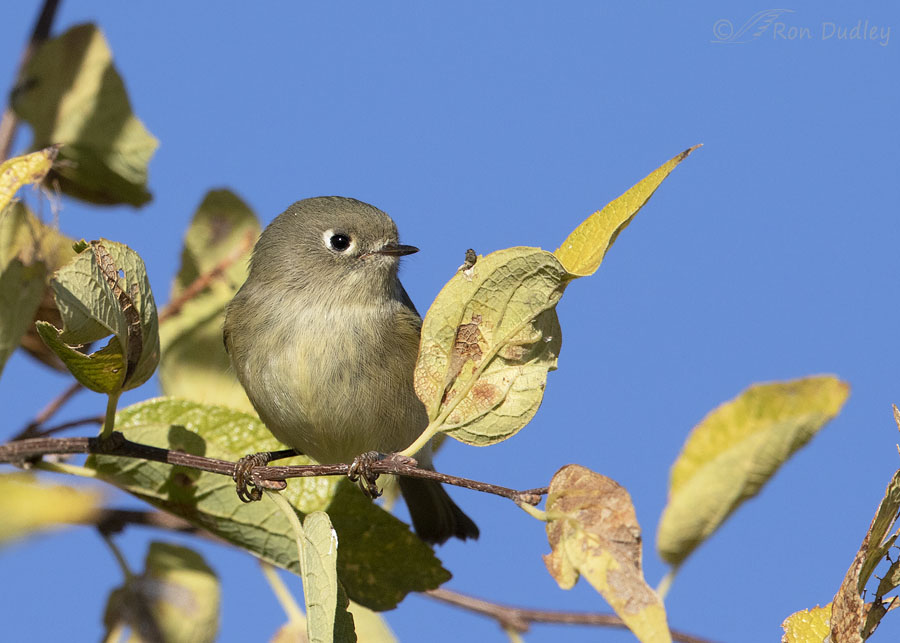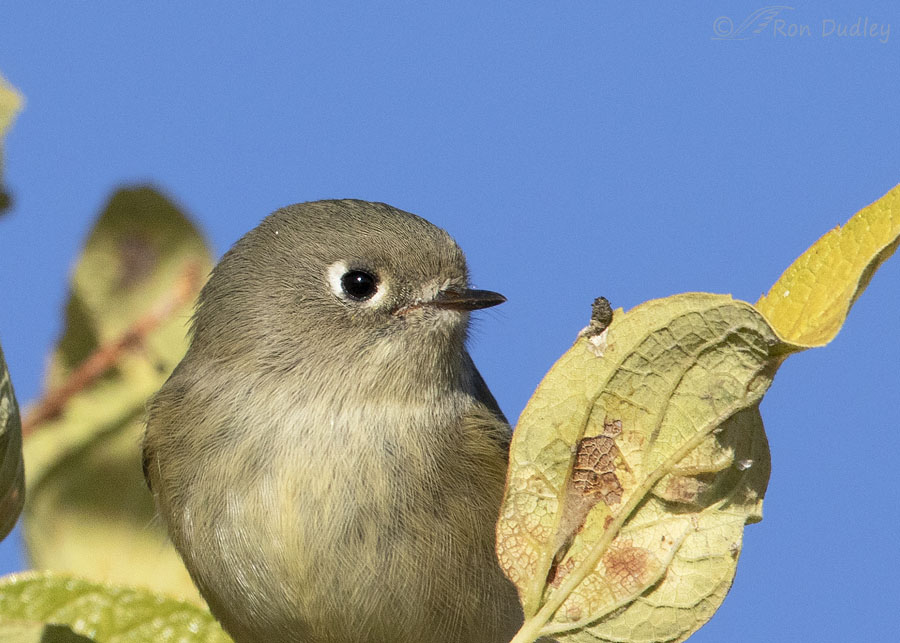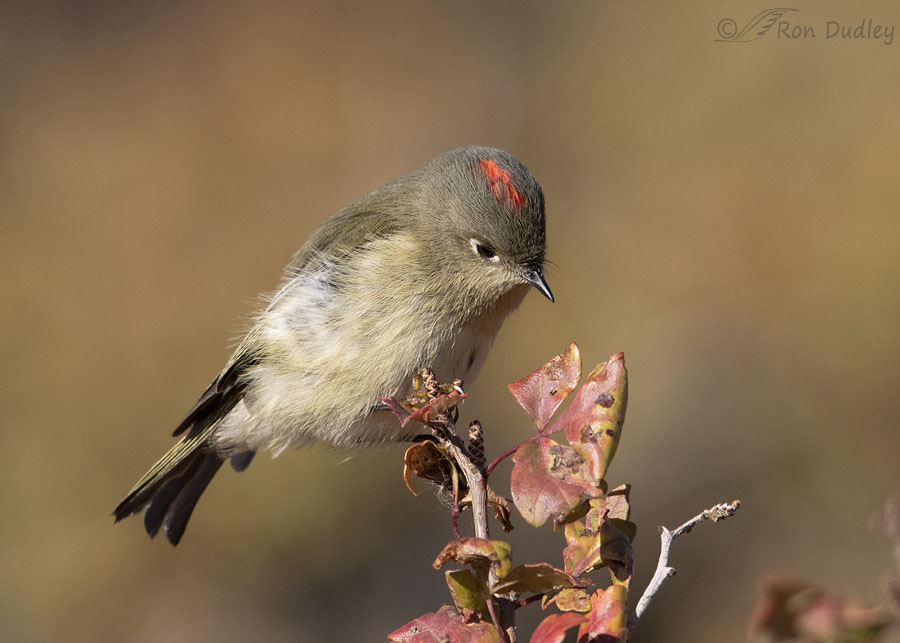A female, I think.

1/2500, f/6.3, ISO 500, Canon 7D Mark II, Canon EF 500mm f/4L IS II USM + EF 1.4 III Extender, not baited, set up or called in
An older photo of a Ruby-crowned Kinglet taken in October several years ago in Box Elder County. For me almost any sharp photo of a kinglet is an accomplishment because of their extremely flitty nature and very small size. Weighing only 6.5 grams they’re a third smaller than Yellow Warblers (9.5 grams) and not much heavier than a nickel.(5.0 grams).Tiny little things.
For most of her short time on this perch she was looking to her right but for a second or two she seemed transfixed by the blob on top of the leaf to her left and directly in front of her face. The blob turned out to be…

bird poop that must have been evacuated while its original owner was in flight since there were no leaves or twigs directly above this perch. To me her facial expression seems to be saying “How did that get there?.”
In case you’re wondering why I chose to refer to ‘her’ as female, it wasn’t much more than a semi-educated guess.

Males and females of this species are identical except for the scarlet (ruby) crown patch of the males. But unless they’re excited about something the males usually keep their crown patch concealed so the kinglet in the first photo could have been either male or female.
But this photo was taken within a few minutes of the first photo and several other males that morning besides this one were also excitedly revealing their crown patches and the bird in the first photo never did, at least that I noticed.
So I just went with the odds and referred to ‘her’ as a female. I really don’t like calling birds “it” and I’m not comfortable using gender neutral pronouns with them either.
Ron


Beautiful images. I hope I get one in my yard again this fall and winter.
I see a look of consternation as she eyes that pooplet. 😉 Thank you for the tighter crop — not to see the poo, but to see more of her fine feather detail. The male is quite lovely too.
And yes, I did get out of my chair to go find a nickel to gauge just how light they are. Amazing!
“And yes, I did get out of my chair to go find a nickel to gauge just how light they are”
I love that in you, Marty. You’d make a good science teacher… 🙂
Well, definitely a weird one! 🤪😹
It appears that the latin name translates to something like “glowing little prince”, which your photos certainly display. Glad you thought to resurrect these from the archives.
Lyle, lately I’ve often thought of you when I add the scientific names to my tags, knowing how interested in them you are. Makes me try not to make any mistakes…
I had a couple of these magical little birds visit my fountain and nearby shrubs quite often last spring, “flitty” really doesn’t begin to describe their constant activity! They are so fun to watch and try to guess where they’ll go next. And yes, I’m pretty easily entertained … by birds! 😎
Oh dear, I neglected the *most* important part — you have captured the magic of RC Kinglets in these photos! ♥️
Chris, I can tell from what you said that you fully realize just how flitty they are!
Wonderful photos and fun birds to have around. In the home we moved from last year, in the south hills, Ruby-crowned Kinglets were regular visitors to our suet and feeders everyday from September through early May (they breed at higher elevations and have an elevational migration rather than north-south). I even had one take Bark Butter (a spreadable suet based product) off of my finger as I spread it on a feeder. Even when not excited, males often still show a streak of red, but not always. But when exposed, the bright red crown is very obvious. Red is often a warning signal that shows aggression or willingness to fight if necessary. Look at male Red-winged Blackbirds with their red wing patches if full display to defend their territory. Then watch them feed communally and notice that the red is covered. If a male is jostled by another, it will suddenly show a flash of red, then quickly re-cover it and return to feeding. Similarly, Ruby-crowned Kinglets often flash their red. They are tiny and not if flocks and the red alerts anyone in the nearby bush that “I’m here” and they are not usually shy about asserting themselves. Golden-crowned Kinglets don’t show the same behaviors and the red is always visible on males. They are flocking and often have several individuals in a group. They usually remain higher in the conifers and often mix with nuthatches and chickadees, with Ruby-crowned don’t deliberately mix with. Fun birds but getting one to sit still long enough for a good photo can be tricky.
Dan, thanks for the detailed info, once again!
And your last sentence is yet another understatement in my experience.
Are golden-crowned the same in size and only the males showing the color?
Connie, Golden-crowned Warblers are half a gram lighter in weight (6 grams instead of 6.5 grams).
Here’s what Cornell has to say about your second question:
“Females contain only yellow hydroxy-carotenoid pigments in crown patch; in males eight different carotenoid pigments contribute to crown coloration”
Thank you for these lovely photos of the Ruby-Crowned Kinglet. They are incredibly shy so I was surprised to learn they are regular winter visitors to my yard! Since they won’t stay still and visible long enough for me to get a good look I really am enjoying these pics. Thank you for all you do for nature and to educate us, your loyal followers.
Melanie, “incredibly shy” and “won’t stay still” are understatements, aren’t they. Especially the latter.
Lovely shots and exciting colour on the top of the male’s head
Thank you, Pat.
Given their tiny size, I see that it’s an accomplishment for you to even spot
this little charmer,
let alone focus and capture her portrait so nicely– love the color balance
in the first shot , by the way…..I guess the eye-light and the ruby crown
must be an either/or proposition for the photographer, or would it be
conceivable to get both in one image ?
Kris, it’s possible to get both but it isn’t easy. Personally I think it’s harder to get a catchlight in a hummingbird’s eye in the same photo its gorget is showing its entire iridescence.
That is really neat with the red crown. I have taken just two or three shots of these guys and gals, but have never gotten the crown. Really excellent shot.
Thanks too for the detailed description. Was not really aware of just how small they are. Remarkable weight comparison to a nickel.
And thanks for choosing the gender. No general neutral pronouns for guys my age.
Everett, I went years without getting any kinglet photos at all, except for a few crappy ones of a single bird taken through my bedroom window. I’ve had a little better luck with them in recent years.
Cute little devil……. 🙂 Definitely tiny and ruby spot is sure a contrast! Must use the spot for communication or breeding purposes?
“Must use the spot for communication or breeding purposes”
Judy, my guess would be both. But I dunno…